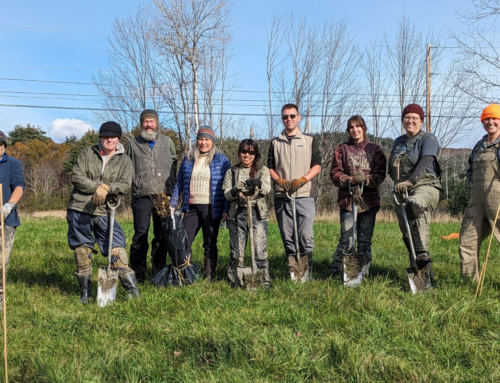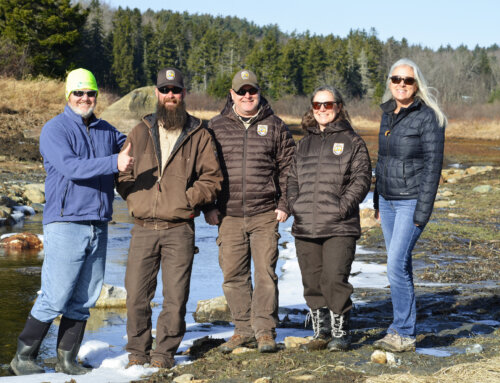Nancy McGarigal
Silvio O. Conte National Fish and Wildlife Refuge
103 E. Plumtree Road
Sunderland, MA 01375 via digital service
Dear Nancy,
The Connecticut River Watershed Council is a nonprofit membership organization that has worked since 1952 to protect the environmental values that directly and indirectly support the state, regional, and local economies and quality of life throughout the four state watershed. CRC has been an active participant with Conte programs, projects, and planning since before its launch. We are proud to have donated Third Island which was the first parcel of land in the Refuge as well as Saddle Island this past year.
CRC supports the Conte Refuge as a concept and as an on the ground reality. Over the years, CRC has seen the positive impacts the Refuge made to the river, its watershed, and the species that depend on the river. We have seen the Refuge help increase citizen awareness of the river and its positive impacts of the quality of life in the valley grow. The Conte has demonstrated responsible and innovative land management and improvements to public access to our land and water resources.
CRC supports many of the elements of the draft CCP. We support an ongoing presence of the Refuge in the watershed. We support the willing seller/willing buyer approach used to establish the CPAs and the CFAs whether by easement or fee simple. We support the education and outreach efforts of the Refuge. CRC will continue to be an active partner as the Refuge moves forward over the 15 years of this CCP.
We do have a few comments for your consideration.
From our reading there is not enough focus on the “Fish” in the “Silvio O. Conte National Fish & Wildlife Refuge” throughout the document. There is laudable focus on how the Service proposes to manage a variety of Refuge lands, but no specificity on how it will support the work to restore migratory fish or enhance resident and sport fisheries. The revised CCP should include information to this end.
Similarly there is little specific mention of how the Service is going to devote resources from not just Refuge funding but the many other programs within the Service that have bearing on the purposes of the Refuge and the aims of the CCP. For plans to be meaningful they must map how their goals and objectives will be implemented. The revised CCP should describe the resources needed from Refuge funding, but also from the various other programs including the Connecticut River Coordinator’s program, Ecological Services (including the Partners for Fish & Wildlife program), Science Applications (and the NA LCC and Connecticut River watershed pilot). We would hope to see an amount of dedicated resources from the several relevant programs commensurate with the vision articulated for whichever Alternative is selected. Otherwise you run the risk of proposing an idle promise.
The CCP states the Service’s preference for Alternative C. That Alternative seeks to expand approved acquisition authority an additional 100,000 acres over Alternative B. CRC does not agree with the choice of Alternative C but prefers Alternative B. Alternative B would still allow for the Refuge to grow by another 60,000+ acres and includes all of the new partnership and focus areas delineated in the plan.
There are several reasons for our choice of Alternative B.
A number of affected towns aware of the West River Conservation Focus Area located in Windham County, Vermont have voiced their objections to fee simple purchases and CRC knows they are not alone in their experience with or attitude about federal ownership of land. These municipalities are concerned about the loss of tax revenue as the Refuge does not modify its refuge revenue sharing payments as land values change upward in a community. The Refuge follows the usual federal government approach in this area. The result is that significant lands under federal ownership usually result in the loss of tax-revenue at the local and or state level. We do note that while this loss of tax revenue is real, conserved land also significantly reduces the tax burden of a community as it does not require the same level of services of a residential or commercial development.
In Vermont, in particular because of the statewide education fund that underwrites school expenditures at the local level, the underfunding of refuge revenue sharing has a direct impact on state expenditures on education funding requiring the state general fund to make up the difference between the inadequate revenue sharing payment and the assessed value of the property.
CRC would like to suggest that the Refuge seek to implement its habitat conservation goals through the acquisition of conservation easements or facilitation of third party acquisition of easements, not through a large expansion of fee simple purchases envisioned in Alternatives C and D. This approach would lower the total expenditures by the Refuge for additional fee simple land purchases and reduce the possibility of friction because of the state and local tax implications of fee ownership. This approach would offer the benefit of the partnerships that the Refuge would make with local organizations in pursuing the Refuge goals.
While the amount of fee simple lands is an outstanding difference among the Alternatives, virtually all other activities between Alternative B and Alternative C are the same, same objectives, same strategies, and activities. In many cases, there are no differences among Alternatives B, C, and D in those areas as well.
It is important that the Refuge decision makers understand, CRC supports Alternative B for the reasons stated in that we feel this will better position the Refuge relative to local support for the Refuge over these ensuing 15 years of the CCP. We are not fixedly opposed to Alternative C but feel that that choice could exacerbate an already prevalent feeling about the insensitivity of the federal government to local town property tax issues. Indeed with a renewed commitment to refuge revenue sharing CRC would be an enthusiastic supporter of Alternative C.
Even though it is a new approach to conservation in the Refuge, CRC particularly supports the addition of the concept of the Quonatuck mainstem division in all Alternatives. This is an important addition along with the other new conservation partnership and focus areas. The shore of the river is an important riparian area in that it is a wildlife corridor, affects the health of the river itself through the contribution of large woody debris to the river, and by providing shade for the immediate shoreline area. The protection of riparian areas will help counter (even if only in a modest way) the thermal gain problems faced by the river due to the river being exposed to unrelenting sun, as it is one long reservoir behind 13 hydroelectric dams. This division should remain in any eventually selected Alternative as a focus area.
The Conte CCP sets out a very well-thought and thoroughly documented course of options for the Refuge over the next 15 years. The Conte is the nation’s most unique refuge given its geography, enabling legislation, commitment to sophisticated partnerships, and focus on both fish & wildlife. It is a model for the entire Refuge system. We do however note with concern that the continued reductions in Refuge funding nationally as well as reductions in the capacity of the Conte Refuge are running at odds with the vision of the Conte. As the final CCP is developed we look forward to continuing to work with the leadership of Region 5 to bring creative solutions to the table that integrate resources from a variety of FWS programs (Partners for Fish & Wildlife, Ecological Services, Fish & Aquatic Conservation, Science Applications, NA LCC, et al.) in order to make our mutual vision for the Conte manifest. With both a final CCP and the Connecticut River Watershed pilot it is imperative that USFWS think strategically across programs in order to remain the fully engaged and supported partner that the Service has traditionally been.
CRC and the many partners that support the Conte have worked very hard to continue to bring federal, state, local, and private resources to the mission of this unique Refuge over the years. CRC itself has begun raising new foundation and private support in order to help the Refuge and the Connecticut River Coordinator’s programs for aquatic invasives, fisheries population assessment and restoration and other basic research. We are committed partners who do our share, we look forward to helping the Service maintain and improve its commitment to all of its programs, including the Conte Refuge.
CRC would like to thank you for the opportunity to comment on the Conte Refuge CCP. CRC stands ready to implement the activities of the Refuge over the next 15 years.
Sincerely,
Andrew Fisk, Ph.D.
Executive Director







